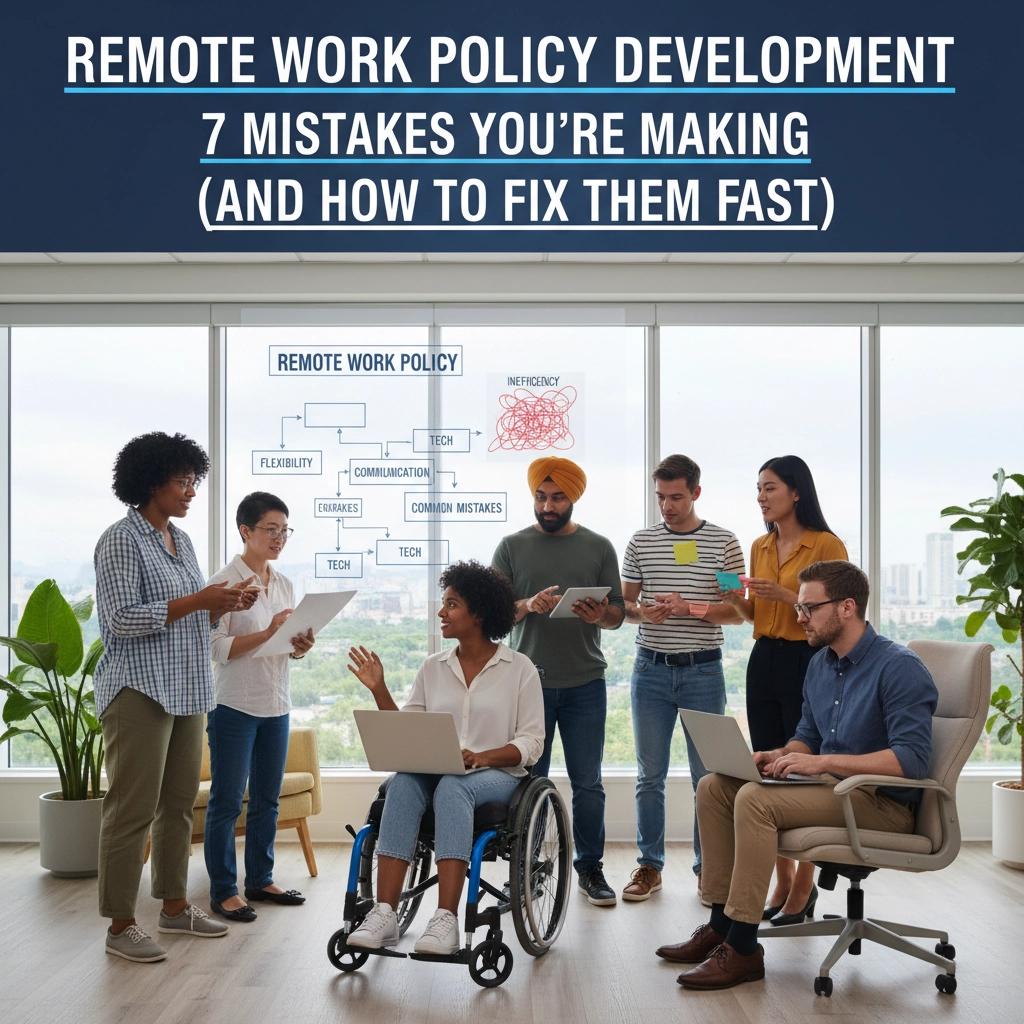Remote Work Policy Development: 7 Mistakes You're Making (And How to Fix Them Fast)

Remote work isn't going anywhere. But here's the thing: most organizations are still figuring it out as they go, and that's creating some costly mistakes in their remote work policies. If your team is struggling with unclear expectations, communication breakdowns, or compliance headaches, you're not alone.
We've worked with countless organizations to help them build remote work policies that actually work. The good news? Most of these issues can be fixed faster than you think. Let's dive into the seven biggest mistakes we see: and how you can address them right now.
Mistake #1: Swinging Between Too Vague and Too Rigid
You know what's confusing? A policy that says "communicate effectively" without explaining what that means. You know what's equally frustrating? A policy that dictates exactly when employees can take bathroom breaks.
Most organizations swing between these two extremes. Policies that are too vague leave managers and employees guessing, creating anxiety during an already challenging transition. But overly rigid structures kill the flexibility that makes remote work valuable in the first place.
The Fast Fix: Create detailed frameworks, not detailed rules. Your policy should answer "what" and "why" while leaving room for "how." For example, instead of saying "maintain regular communication," specify "provide weekly progress updates to your manager and respond to team messages within 4 hours during business hours." This gives clear expectations without micromanaging the method.

Mistake #2: Building Policies Based on Distrust
Nothing kills remote work morale faster than policies that assume your employees are looking for ways to slack off. When your policy focuses more on monitoring and surveillance than on outcomes, you're essentially telling your team you don't trust them to do their jobs.
This shows up in policies that require constant check-ins, productivity software that tracks every keystroke, or rigid schedules that don't account for the flexibility that drew people to remote work in the first place.
The Fast Fix: Start with trust as your default setting. Focus your policy on deliverables and results rather than activities. Replace "employees must be available on Slack from 9-5" with "employees should meet project deadlines and attend scheduled team meetings." When you trust your people, they usually rise to meet that trust.
Mistake #3: Forgetting to Define Communication Strategy
Here's a scenario we see all the time: Leadership sets ambitious goals but doesn't provide the communication structure to achieve them. Teams are left wondering who makes decisions, how information flows, and when they should expect responses.
Without clear communication protocols, you get duplicated efforts, missed deadlines, and frustrated employees who feel like they're working in isolation.
The Fast Fix: Define two things immediately:
- Clear reporting structures - Everyone should know who they report to and who reports to them
- Communication protocols - Establish which tools are used for what (Slack for quick questions, email for formal communications, video calls for complex discussions), expected response times, and regular check-in schedules
This doesn't mean more meetings: it means more intentional communication.
Mistake #4: Ignoring Time Zones and Asynchronous Work
If your remote work policy assumes everyone will be online at the same time, you're missing the point of distributed teams. Forcing employees in different time zones to attend early morning or late evening meetings regularly isn't sustainable.
Many organizations also fail to build asynchronous work practices into their core processes, creating bottlenecks when key decision-makers aren't available.
The Fast Fix: Build asynchronous work into your DNA from day one. Document decisions in writing, use project management tools that don't require real-time collaboration, and establish meeting guidelines that rotate timing fairly across time zones. Create clear handoff processes so work can continue even when team members aren't online simultaneously.

Mistake #5: Creating a Two-Tier System
One of the costliest mistakes is treating remote employees as second-class citizens. This shows up in subtle ways: remote workers getting passed over for promotions, missing out on informal networking opportunities, or not having access to the same resources as office-based colleagues.
Research consistently shows that remote employees are less likely to receive raises or advancement opportunities, and this disparity often starts with policy design.
The Fast Fix: Audit your policy for equity gaps. Ensure remote employees have equal access to:
- Professional development opportunities
- Mentoring and coaching programs
- Equipment and resources
- Career advancement pathways
- Social and team-building activities
If differences exist due to practical constraints, your policy should transparently explain why and outline how you're working to minimize the impact.
Mistake #6: Making It Too Complicated
Complex policies don't get followed. Period. When your remote work policy reads like a legal document, employees either ignore it or spend more time trying to understand it than actually working.
Overcomplicated policies often result from trying to address every possible scenario upfront, leading to documents that are intimidating and impractical.
The Fast Fix: Keep it simple and actionable. Use plain language and focus on the most common situations. Instead of "employees should maintain appropriate data security protocols," be specific: "use the company VPN, enable two-factor authentication, and lock your computer when stepping away."
Create a one-page quick reference guide that covers the essentials, with the full policy available for detailed questions.

Mistake #7: Overlooking Legal and Compliance Requirements
This is the mistake that can cost you big time. Remote work creates complex legal considerations, especially when employees work across state or country lines. Labor laws vary dramatically: California's overtime requirements look nothing like those in Texas.
Many organizations discover compliance gaps only when facing wage disputes or regulatory audits. Data security, work environment obligations, and documentation requirements often get overlooked in the rush to enable remote work.
The Fast Fix: Get legal help now, not later. Work with employment law specialists to understand:
- Wage and hour requirements for each state where you have remote employees
- Data privacy and security obligations
- Workers' compensation and safety requirements
- Documentation and record-keeping needs
Include specific security procedures and legal compliance requirements in your policy rather than vague guidelines. Update these regularly as laws evolve.
Moving Forward: Build Policies That Work
The best remote work policies balance structure with flexibility, trust employees while maintaining clear expectations, and evolve with your organization's needs. They're living documents that get better through feedback and iteration.
Start by addressing these seven mistakes, but don't stop there. Survey your employees regularly about what's working and what isn't. Track metrics like retention, productivity, and employee satisfaction to measure your policy's effectiveness.
Remember, you don't have to figure this out alone. Building effective remote work policies requires understanding both organizational behavior and legal compliance: areas where expert guidance can save you time, money, and headaches.
The goal isn't to create the perfect policy from day one. It's to create a foundation that supports your team's success while protecting your organization. Get the basics right, then refine as you learn.
Your remote work policy should feel like a helpful guide, not a restrictive rulebook. When you get it right, it becomes a competitive advantage that attracts top talent and enables sustainable growth( regardless of where your team is located.)
